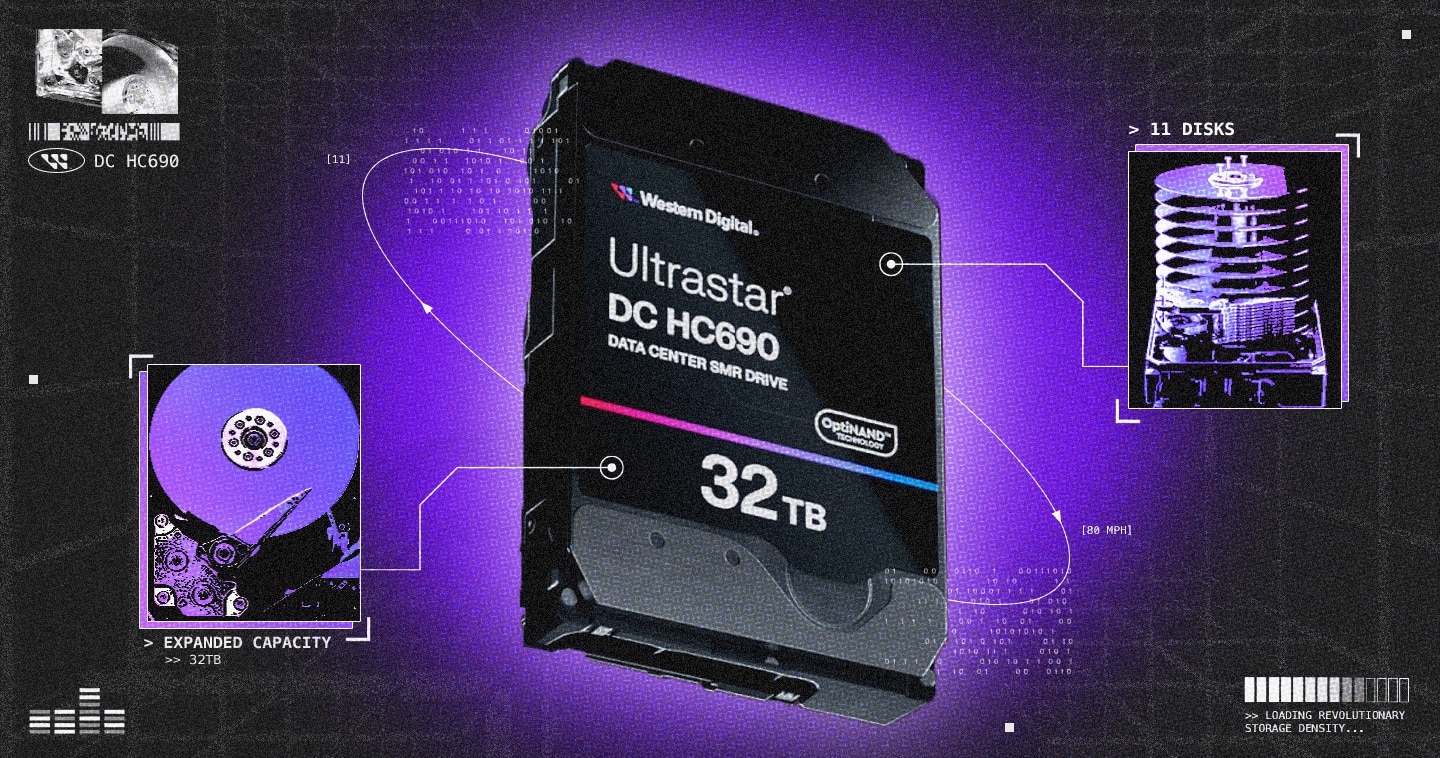Western Digital Increases HDD Capacity Without Increasing Size
As data centers and enterprises continue to face increased demands on their storage infrastructures, innovations in HDD technology consistently strive to deliver the capacity gains required to meet those demands, such as those currently propelled by the AI Data Cycle.
AI systems process and generate vast amounts of data that must be stored efficiently. HDDs play a crucial role in this ecosystem, handling both the input side, where data is gathered, ingested, and stored, and the output side, where AI content is generated and preserved.
Why Increasing HDD Capacity Matters
Western Digital, a pioneer in the HDD industry, continues to push the limits of density and capacity with its innovative HDD technologies as workloads like AI increase the need for storage.
To that goal, the company unveiled its new Ultrastar® DC HC690, the industry’s highest capacity ePMR drive with up to 32TB1 of storage, which is also the industry’s first 11-disk HDD.
One way to increase storage capacity is to add more disks, but they need to fit within the well-established, industry standard sized enclosure. Changing the size of the enclosure would require data center architects to refit rack space to make room for larger sized HDDs to reap the benefits of added capacity or new features. The challenge for Western Digital’s engineers was finding a way to add an 11th disk to an already compact HDD.
Inside the Engineering Behind the 11-Disk HDD
There are dozens of components and subsystems that make up a hard drive. Takashi Nakamura, senior director for Western Digital’s HDD Program Management Office (PMO), oversees the entire development process and is responsible for managing the schedule, features, budget, and resources required to build the next generations of HDDs.
Nakamura works with each of the engineering teams on plans to incorporate all of a hard drive’s design elements into a single product.
“As each generation of HDDs evolve, we look at what we can do to increase capacity and performance,” Nakamura said.
One of these teams is a group of mechanical design engineers based in Fujisawa, Japan, that focuses on the mechanical design of HDDs, all its components other than the read/write head and media.
Takaaki Deguchi manages this mechanical design team, based in Fujisawa, Japan, that brought the 11-disk HDD to fruition. The process began in 2022 with an evaluation of possible options to fit yet one more platter within its ultra-compact design.
“Without changing the total height [of the HDD], we thought, how can we add one more disk?” Deguchi said. “You either have to reduce the disk-to-disk spacing, the disk thickness, or other parts like the base casting or top cover thickness.”
How Western Digital Fit 11 Disks into a Standard HDD Enclosure
Historically, HDD capacity increases that were achieved by adding disks relied on a combination of making disks thinner and decreasing the space between each disk. However, for the 11-disk design there were significant manufacturing efficiencies to be realized by keeping the same disk thickness. The team decided to depart from historical precedent by focusing on decreasing the disk spacing, or the gap between each disk.
With the strategy set, the development team began working to limit the overall height of the disk stack, thereby minimizing the impact to the HDD enclosure. The changes were many—from minimizing the space required to load and unload the heads onto and off the media, working with the supply chain to reduce mechanical tolerances, and optimizing key elements of Western Digital’s manufacturing assembly processes.
An HDD uses magnetic disks, or platters, to store data. The disks spin at speeds greater than 80 miles per hour (mph) at the outermost region, while an arm with read and write heads flies over the spinning disk to retrieve or write data.
With each new generation, the precision required to allow an HDD’s recording head to fly over the spinning disk surface is analogous to a 747 flying even closer than one millimeter above the ground without touching it.
To accommodate the reduction in disk spacing, a lower profile suspension, which enables the recording head to precisely fly over the disk surface, was needed. Changes were kept to a minimum, allowing the team to incorporate Western Digital’s industry leading 2nd generation Triple Stage Actuator design largely unchanged.
But reducing the space between disks was not enough.
With the disk spacing defined, additional savings were still necessary to stay within the industry standard form factor. This required reducing the hard drive’s base casting thickness while not degrading the stiffness of the entire structure.
The PCBA’s shape was modified to avoid overlapping with the disk stack. The PCBA, or printed circuit assembly board assembly, contains nearly all the electrical components of a drive, soldered onto a board.
Special care was taken to not change any element of the design and manufacturing processes related to Western Digital’s HelioSeal® technology, allowing the new 11-disk platform to leverage the quality and reliability of nearly 150 million helium drives already shipped.
“To add an 11th disk without compromising the performance of the product is an impressive accomplishment,” said Bob Reinhart, senior director of mechanical engineering for the HDD business. “It wasn’t one or two changes that enabled this, but rather a careful examination and optimization of a multitude of design elements. It literally was a case of unlocking a few microns of space savings in targeted areas that collectively resulted in something quite significant.”
Focus on power consumption
Power consumption is a huge consideration for data centers. Even though the team added another disk, the final design consumed the same power.
“Normally adding a disk would result in increased power consumption,” Reinhart explained. “However, during the 11-disk platform development, we intentionally optimized the design of several key components to lower their overall windage drag.”
Windage drag, the force that opposes the relative motion of an object through air, is analogous to opening a car window and feeling the rush of wind on your hand. If you modify the shape or direction of your hand, you can feel the change in force exerted by the wind.
“The new design is more aerodynamic against the effects of multiple spinning disks at high velocity,” Reinhart said. “The design team set out to minimize the expected power increase but ended up achieving equivalent power. Customers care deeply about power consumption and sustainability, so it was significant for us to be able to add a disk while meaningfully reducing the power consumption on a per unit capacity basis (watts/terabyte).”
Scaling to 50TB Without Changing the Drive Size
This unique combination of field-proven designs with the latest innovative technologies provides increased storage capacity without increasing the storage infrastructure, or footprint.
“By adding one disk and two heads, we can achieve that capacity; meaning that we didn’t need to change the head or media technology or add firmware features,” Nakamura said. “In this generation, we were able to focus on the mechanical changes as opposed to the other areas.”
The benefit of greater storage density within the same footprint is that data center operators can increase their overall capacity without adding new storage infrastructure, which would increase their CapEx spend. In addition, maintaining the existing footprint holds power requirements and HVAC needs within current operating ranges, making the most of OpEx spend.
The new 11-disk platform leverages generations of successful hardware and firmware designs and innovative technologies, including the company’s proprietary ePMR, UltraSMR, OptiNAND™, HelioSeal, and ArmorCache™.
With capacities of up to 28TB for CMR and 32TB for SMR, Western Digital continues its journey on the road to 50+TB.
It takes a collaborative team of innovators to continuously improve HDD technologies to stay ahead of the unending growth in data storage needs. Nakamura, Deguchi, Reinhart, and their teams are among the brilliant minds powering these innovations.
“We have a long history of incrementally increasing disks, and therefore capacity, since HDDs were first invented in 1956,” Nakamura said. “The mechanical team is always looking to the next innovation.”
Artwork by Rachel Garcera




